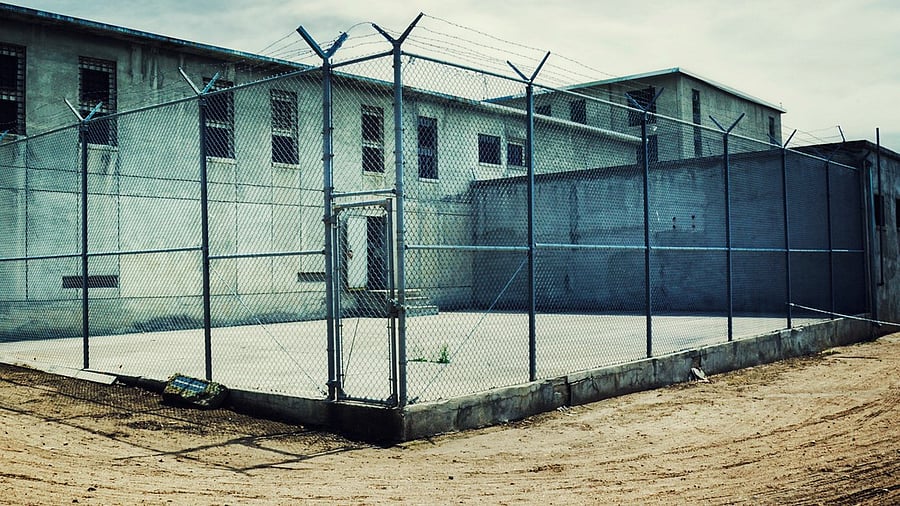
File photo of a prison yard. (Representative image)
Credit: iStock Photo
Hyderabad: Andhra Pradesh remains the state to spend the most on inmates. During 2022-2023, the state spent Rs 2.6 lakh annually—or Rs 733 daily—per inmate across its population of 7,200 prisoners, according to the 2025 India Justice Report (IJR) released Tuesday. The report also said that neighboring Telangana, with a similar inmate population of 6,500, spent Rs 33,277 annually or Rs 91 daily.
Neither state reported prison overcrowding. Both states have among the lowest percentages of undertrials detained for 1-3 years nationwide—7% in Andhra Pradesh and 8% in Telangana. While 86% of Telangana's prisons are equipped with video-conferencing facilities, only 72% of facilities in Andhra Pradesh offer this capability.
Regarding prison staffing, Telangana reported the country's lowest shortfall (9%) among prison officers, while Andhra Pradesh reported a 21% shortfall. Telangana has maintained zero vacancies in correctional staff positions since 2017, whereas Andhra Pradesh has not sanctioned any such positions during the same period. Andhra Pradesh reports the nation's lowest shortfall of prison doctors at just 5%, while Telangana faces a substantial 59% shortage—among the highest nationwide.
The 2025 IJR ranked Telangana first in Police and second in Judiciary categories, with an overall ranking of third among the 18 large and mid-sized states populations over one crore. Andhra Pradesh ranked fourth in Prisons and fifth in Legal Aid, while improving its overall position from fifth in 2022 to second in 2025.
Karnataka retained the top overall position, followed by Andhra Pradesh, Telangana, and Kerala. Among the seven small states (populations under one crore), Sikkim maintained its first-place ranking, followed by Himachal Pradesh and Arunachal Pradesh.
The India Justice Report was initially launched by Tata Trusts in 2019. Now in its fourth edition, the report is produced in collaboration with partners including the Centre for Social Justice, Common Cause, Commonwealth Human Rights Initiative, DAKSH, TISS–Prayas, Vidhi Centre for Legal Policy, and data partner How India Lives.
Through rigorous 24-month quantitative research, the IJR tracks state performance in strengthening justice delivery structures. Using official government data, it integrates information across four justice pillars—Police, Judiciary, Prisons, and Legal Aid. Each pillar is analyzed through metrics including budgets, human resources, workload, diversity, infrastructure, and improvement trends over five years. This edition also evaluates 25 State Human Rights Commissions and features essays on mediation and justice access for persons with disabilities.
"As India moves forward into a hundred years of being a democratic, rule of law nation, the promise of rule of law and equal rights will remain hollow unless underwritten by a reformed justice system. Reform is not optional. It is urgent," said IJR Chief Editor Maja Daruwala.
Both states reported over 50% women in district courts, with Telangana leading nationally at 55%. Telangana also outperformed Andhra Pradesh with 33% women in its High Court. In policing, Andhra Pradesh leads the nation with 22% female representation, while Telangana reports just 9%.
As of 2025, Andhra Pradesh recorded one of the country's lowest vacancy rates (12%) among district judges, while Telangana reported 21%. At the High Court level, Andhra Pradesh maintained a 19% judicial vacancy rate since 2022 while achieving the largest reduction in staff shortfalls—from 51% to 18%. Telangana recorded 29% vacancy among High Court judges and 24% among staff.
In police staffing, Telangana's vacancies increased since January 2022, with 30% vacancy among constables (up from 26%) and 13% among officers (up from 7%) by January 2023. Andhra Pradesh reported 21% vacancy among constables and 10% among officers.
The IJR 2025 emphasizes both immediate corrections—urgently filling vacancies and increasing representation—and foundational reforms, including designating justice delivery as an essential service.